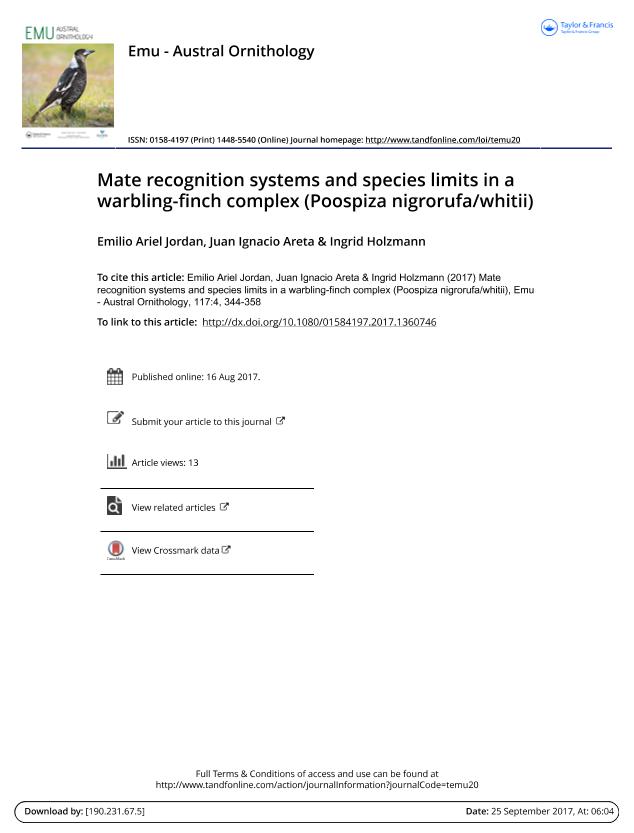Artículo
Mate recognition systems and species limits in a warbling-finch complex (Poospiza nigrorufa/whitii)
Fecha de publicación:
08/2017
Editorial:
Taylor & Francis
Revista:
Emu
ISSN:
0158-4197
e-ISSN:
1448-5540
Idioma:
Inglés
Tipo de recurso:
Artículo publicado
Clasificación temática:
Resumen
Species limits in the Poospiza nigrorufa/whitii complex are not well understood. Three taxa formally described as species are now considered as subspecies (nigrorufa, whitii and wagneri) of a widespread species. The heavier nigrorufa has longer bill, tarsus and wings, is slightly dimorphic with males showing tawny rufous throat, breast and flanks, and brownish grey upper parts with a slate tinge, while females differ in the orange tinge of ventral parts and in the more olivaceous upper parts; inhabits shrubby open areas and wetlands with reeds and bulrushes in eastern southern South America, and gives a simple three-note pattern that repeats to form the song and diagnostic calls. The lighter whitii (including wagneri as a synonym) has a shorter bill, tarsus and wings, is highly dimorphic with males having dark chestnut throat, breast and flanks, and slate upper parts, while females exhibit tawny pale-orange ventral parts, and olivaceous light-brown upper parts; inhabits closed to semi-closed xerophytic to semi-humid scrub and woodlands in the western highlands, and has a complex multi-noted song and diagnostic calls. Reciprocal playback experiments indicate that both taxa are able to discriminate each other’s songs. Locality data and ecological niche modelling show that nigrorufa and whitii are narrowly allopatric or parapatric in central Córdoba province (Argentina).This integrative evidence and the ~2.5% divergence in mtDNA show that nigrorufa and whitii possess different Specific Mate Recognition Systems and should be afforded full species status under any species concept.
Palabras clave:
Poospiza Nigrorufa
,
Poospiza Whitii
,
Species Concepts
,
Species Limits
Archivos asociados
Licencia
Identificadores
Colecciones
Articulos(CICYTTP)
Articulos de CENTRO DE INV.CIENT.Y TRANSFERENCIA TEC A LA PROD
Articulos de CENTRO DE INV.CIENT.Y TRANSFERENCIA TEC A LA PROD
Articulos(IBIGEO)
Articulos de INST.DE BIO Y GEOCIENCIAS DEL NOA
Articulos de INST.DE BIO Y GEOCIENCIAS DEL NOA
Citación
Jordan, Emilio Ariel; Areta, Juan Ignacio; Holzmann, Ingrid; Mate recognition systems and species limits in a warbling-finch complex (Poospiza nigrorufa/whitii); Taylor & Francis; Emu; 117; 4; 8-2017; 344-358
Compartir
Altmétricas




